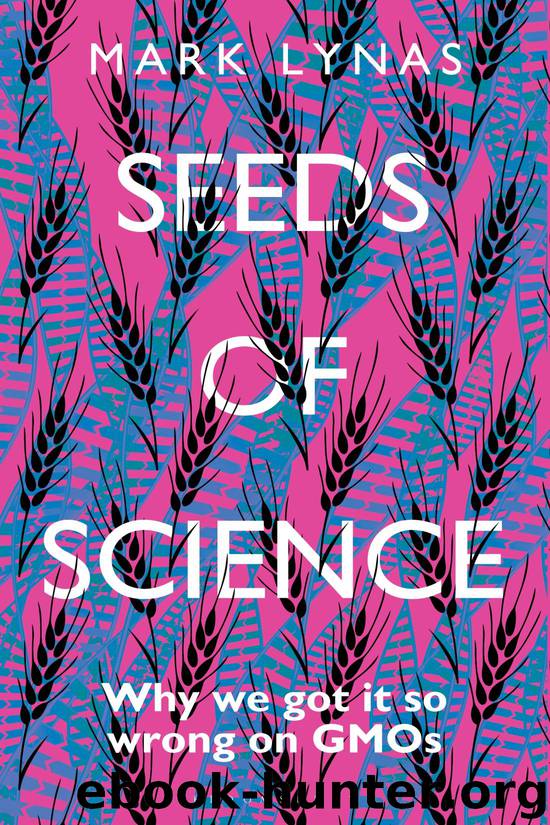Seeds of Science by Mark Lynas

Author:Mark Lynas
Language: eng
Format: epub
Publisher: Bloomsbury Publishing
In mid-February 2017, almost 20 years since I stood in a field of genetically modified maize in England and prepared to destroy it, I was back in Tanzania. The empty test site I had first visited in 2013 was now full of a flourishing and sturdy transgenic maize crop. This maize marked a milestone for the country as the first GMO test ever permitted; these were historic plants I saw rustling in a gentle tropical breeze. Wearing official blue overalls and baking under the intense sun, I looked around at the high fence and pondered at how I seemed to have come full circle. Two decades earlier I had destroyed maize looking very much like this, because it was also genetically engineered. This time I hadn’t come to destroy the crop, I had come to help the scientists who were battling to defend it.
These scientists had won a significant battle the preceding year, succeeding in getting the ‘strict liability’ law relaxed so that they could legally conduct outdoor field trials of genetically modified crops. I was visiting this time not as an individual but as a visiting fellow of the recently launched Alliance for Science at Cornell University, and my mission was to work with the Tanzanian scientists so they could be as effective as possible in getting their story out to the world. The first crop to be planted was the maize I was now examining, part of the Water Efficient Maize for Africa (WEMA) project trialling drought-tolerant corn intended for the use of smallholder farmers in five African countries.18 As well as Tanzania, WEMA maize was in development in Uganda, Kenya and Mozambique, and was already being distributed to farmers in South Africa. The maize plants were tall and strong-looking, easily the most vigorous I had seen so far in the whole country.
Tanzania’s water efficient maize project seemed particularly appropriate because the entire East African region was suffering under a crippling drought, the worst in decades. According to the international Famine Early Warning System, Tanzania was then classed at risk of ‘acute food insecurity’.19 Half of the country’s maize crop had been lost due to drought before the last harvest. As we drove from Morogoro to Dodoma to visit the trial site I could see that the road was lined with mile after mile of failed crops yellowing in their parched fields. It was a depressing sight, not least because I knew that it would be likely to mean hunger for the subsistence growers that depended on them.
Farmers I spoke to told a bleak story of rains that never came. ‘The weather this year honestly is not like any other I have ever seen since I came to Dodoma; this is the most severe,’ Regina Mwashilemo, one of these farmers, told me. She lived in the neighbouring village, Veyula, just a few dusty miles from the site of the GMO field trial. The proud owner of three emaciated cows, about a dozen chickens and a couple of goats, she supported five children and two grandchildren on just a few acres of land.
Download
This site does not store any files on its server. We only index and link to content provided by other sites. Please contact the content providers to delete copyright contents if any and email us, we'll remove relevant links or contents immediately.
Craft Beer for the Homebrewer by Michael Agnew(18123)
Marijuana Grower's Handbook by Ed Rosenthal(3606)
Barkskins by Annie Proulx(3287)
Project Animal Farm: An Accidental Journey into the Secret World of Farming and the Truth About Our Food by Sonia Faruqi(3163)
The Plant Messiah by Carlos Magdalena(2868)
Red Famine: Stalin's War on Ukraine by Anne Applebaum(2857)
0041152001443424520 .pdf by Unknown(2771)
Organic Mushroom Farming and Mycoremediation by Tradd Cotter(2616)
In the Woods by Tana French(2518)
Beer is proof God loves us by Charles W. Bamforth(2358)
7-14 Days by Noah Waters(2345)
Reservoir 13 by Jon McGregor(2228)
Borders by unknow(2214)
Meathooked by Marta Zaraska(2210)
The Art of Making Gelato by Morgan Morano(2202)
Birds, Beasts and Relatives by Gerald Durrell(2164)
Between Two Fires by Christopher Buehlman(2147)
The 7 Habits of Highly Effective People: Powerful Lessons in Personal Change (25th Anniversary Edition) by Covey Stephen R(2120)
The Lean Farm Guide to Growing Vegetables: More In-Depth Lean Techniques for Efficient Organic Production by Ben Hartman(2087)
